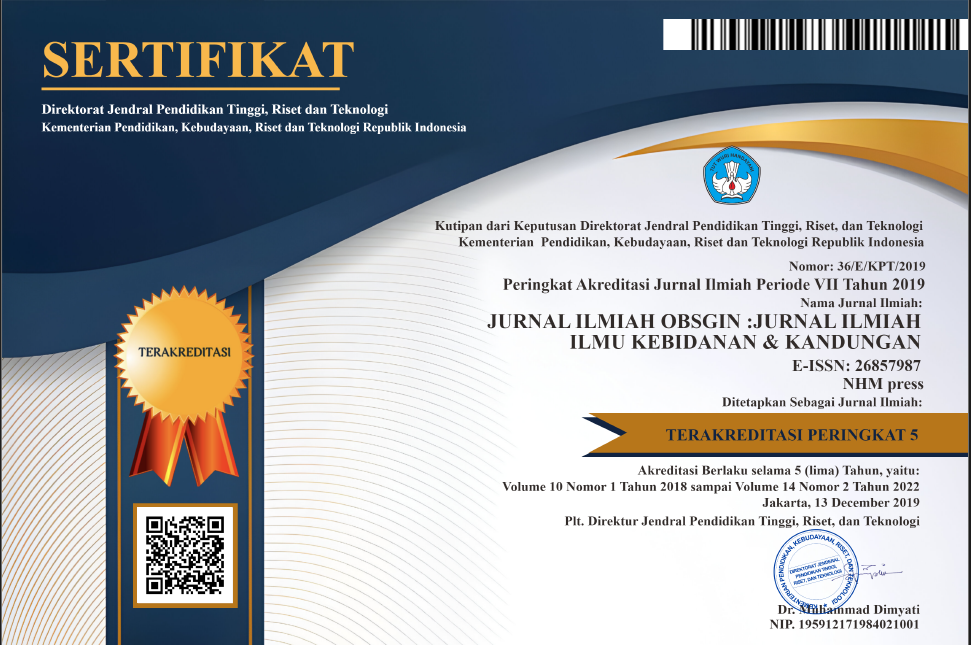THE CORRELATION OF NUTRITION STATUS WITH THE ACTIVITY OF PRESCHOOL CHILDREN IN PAMULIHAN VILLAGE, CILACAP JAWA TENGAH
Keywords:
therapeutic communication, anxiety level
Abstract
Introduction: The purpose of this study was to determine the correlation of nutrition status with the activity of preschool children. The population is the parents who have preschool children. Samples were obtained by purposive sampling. The research was conducted in July. Analysis of the data used is SPSS. Based on the calculation, the calculated value is 0,014 with a significant value of 0,05 (p<0,05). The conclusion is that there is a correlation between nutritional status and The activity of preschool children in Pamulihan village, Cilacap Jawa Tengah.
References
Harinda Et Al., 2012)Darussalam, U., & Aceh, B. (2017). Hubungan Status Gizi Dengan Fisik Motorik Anak Tk Fkip Unsyiah Darussalam Banda Aceh Cut Rica Fitriya Ananda 1* ,. 2(2), 44–57.
Fakultas, M., Masyarakat, K., Tahun, U. S. U., & Damanik, T. K. (2014). No Title.
Fitria. (2013). 済無no Title No Title. Journal Of Chemical Information And Modeling, 53(9), 1689–1699.
Harinda, L., Pendidikan, P., Kedokteran, S., Kedokteran, F., & Diponegoro, U. (2012). Dengan Kesulitan Makan Di Semarang ( Studi Kasus Di Kelurahan Tandang Dan Sendangguwo ) Jurnal Media Medika Muda Dengan Kesulitan Makan Di Semarang ( Studi Kasus Di Kelurahan Tandang Dan Sendangguwo ).
Ii, B. A. B., & Pustaka, T. (N.D.). No Title. 8–27.
Merita, M. (2019). Tumbuh Kembang Anak Usia 0-5 Tahun. In Jurnal Abdimas Kesehatan (Jak) (Vol. 1, Issue 2). Https://Doi.Org/10.36565/Jak.V1i2.29
Notoatmodjo, S. (2018). Metodologi Penelitian Kesehatan (3rd Ed.). Pt Asdi Mahasatya.
Nursalam. (2017). Metodologi Penelitian Ilmu Keperawatan (P. P. Lestari (Ed.); 4th Ed.). Salemba Medika.
Pendidikan, J., Keluarga, K., Teknik, F., & Semarang, U. N. (2015). Keaktifan Di Sekolah Dengan Status Gizi.
Sambo, M., Ciuantasari, F., & Maria, G. (2020). Hubungan Pola Makan Dengan Status Gizi Pada Anak Usia Prasekolah Pendahuluan. 11(1), 423–429. Https://Doi.Org/10.35816/Jiskh.V10i2.316
Schiavo. (2014). No 主観的健康感を中心とした在宅高齢者における 健康関連指標に関する共分散構造分析title. 1–96.
Seprianty, V., R.M. Suryadi Tjekyan, & Thaha, M. A. (2015). Status Gizi Anak Kelas III Sekolah Dasar Negeri 1 Sungaililin. Jurnal Kedokteran Dan Kesehatan, 2(1), 129–134.
Tk, D. I., & Bantarsoka, D. (2019). Pengaruh Status Gizi Terhadap Perkembangan Kognitif Anak Usia Dini.
Cut Rica Fitriya Ananda (2017). Hubungan Status Gizi Dengan Fisik Motorik Anak Tk FKIP Unsyiah Darussalam Banda Aceh. 2017;2(2):44–57.
Mkhize M, Sibanda M. A. (2020). Review of selected studies on the factors associated with the nutrition status of children under the age of five years in South Africa. Int J Environ Res Public Health. 2020;17(21):1–26.
Fakultas, M., Masyarakat, K., Tahun, U. S. U., & Damanik, T. K. (2014). No Title.
Fitria. (2013). 済無no Title No Title. Journal Of Chemical Information And Modeling, 53(9), 1689–1699.
Harinda, L., Pendidikan, P., Kedokteran, S., Kedokteran, F., & Diponegoro, U. (2012). Dengan Kesulitan Makan Di Semarang ( Studi Kasus Di Kelurahan Tandang Dan Sendangguwo ) Jurnal Media Medika Muda Dengan Kesulitan Makan Di Semarang ( Studi Kasus Di Kelurahan Tandang Dan Sendangguwo ).
Ii, B. A. B., & Pustaka, T. (N.D.). No Title. 8–27.
Merita, M. (2019). Tumbuh Kembang Anak Usia 0-5 Tahun. In Jurnal Abdimas Kesehatan (Jak) (Vol. 1, Issue 2). Https://Doi.Org/10.36565/Jak.V1i2.29
Notoatmodjo, S. (2018). Metodologi Penelitian Kesehatan (3rd Ed.). Pt Asdi Mahasatya.
Nursalam. (2017). Metodologi Penelitian Ilmu Keperawatan (P. P. Lestari (Ed.); 4th Ed.). Salemba Medika.
Pendidikan, J., Keluarga, K., Teknik, F., & Semarang, U. N. (2015). Keaktifan Di Sekolah Dengan Status Gizi.
Sambo, M., Ciuantasari, F., & Maria, G. (2020). Hubungan Pola Makan Dengan Status Gizi Pada Anak Usia Prasekolah Pendahuluan. 11(1), 423–429. Https://Doi.Org/10.35816/Jiskh.V10i2.316
Schiavo. (2014). No 主観的健康感を中心とした在宅高齢者における 健康関連指標に関する共分散構造分析title. 1–96.
Seprianty, V., R.M. Suryadi Tjekyan, & Thaha, M. A. (2015). Status Gizi Anak Kelas III Sekolah Dasar Negeri 1 Sungaililin. Jurnal Kedokteran Dan Kesehatan, 2(1), 129–134.
Tk, D. I., & Bantarsoka, D. (2019). Pengaruh Status Gizi Terhadap Perkembangan Kognitif Anak Usia Dini.
Cut Rica Fitriya Ananda (2017). Hubungan Status Gizi Dengan Fisik Motorik Anak Tk FKIP Unsyiah Darussalam Banda Aceh. 2017;2(2):44–57.
Mkhize M, Sibanda M. A. (2020). Review of selected studies on the factors associated with the nutrition status of children under the age of five years in South Africa. Int J Environ Res Public Health. 2020;17(21):1–26.











